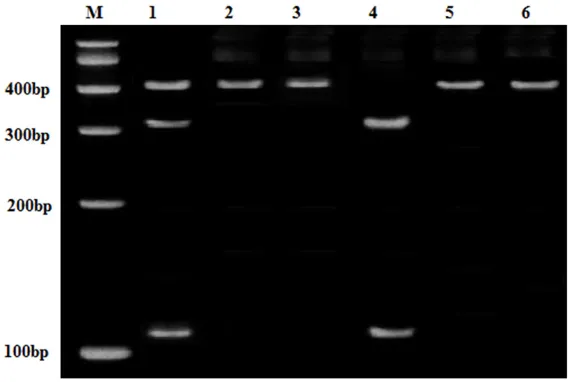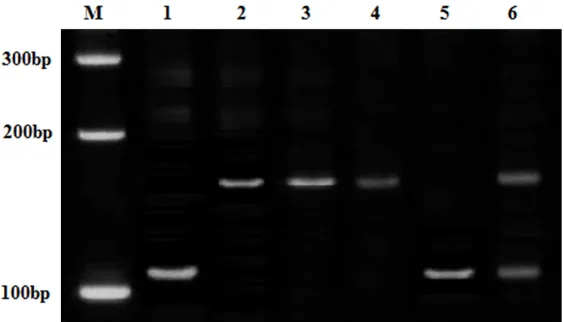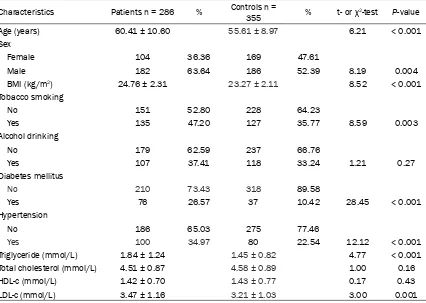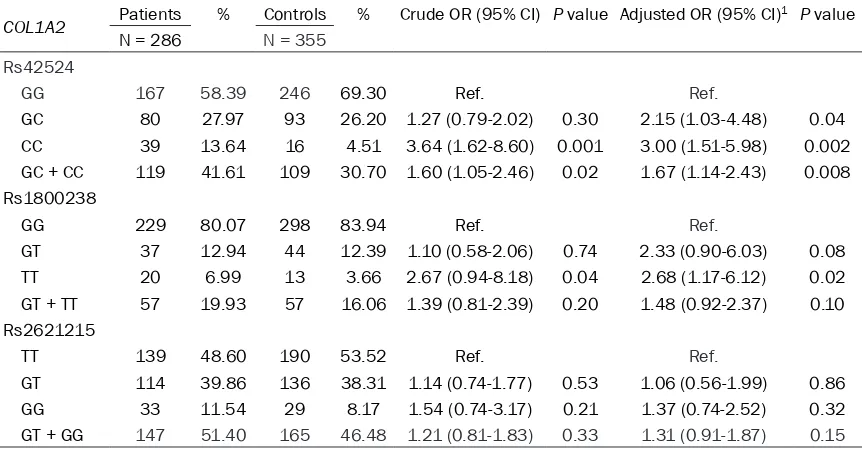Original Article
Association between
COL1A2
gene polymorphisms and
susceptibility to the intracerebral hemorrhage in a
Chinese population
Lijun Dan1, Zhengang Jia2, Shujuan Yang3, Bo He4
Departments of 1Emergency, 2Neurology, Xing Yuan (4th) Hospital of Yulin, Yulin 719000, China; 4Critical Care Medicine, Xing Yuan (4th) Hospital of Yulin, Yulin 719000, China; 3Department of Health and Social Behavior, West China School of Public Health, Sichuan University, Chengdu 610041, China
Received January 29, 2016; Accepted September 5, 2016; Epub November 15, 2016; Published November 30, 2016
Abstract: We firstly conducted a study to investigate the role of three common SNPs (rs42524 in exon 28, rs1800238
in exon 32, and rs2621215 in intron 46) in the susceptibility to intracerebral hemorrhage. A total 286 patients with proven intracerebral hemorrhage and 355 control subjects were consecutively recruited between May 2012 and
October 2014. The DNA was extracted from venous blood samples using the TIANamp Blood DNA Kit (Tiangen Biotech, Beijing, China). Genotyping of COL1A2 rs42524, rs1800238, and rs2621215 was performed using poly
-merase chain reaction-restriction fragment length polymorphism (PCR-RFLP). We found that the frequencies of the GG, GC and CC genotypes of COL1A2 rs42524 were significantly different between patients with intracerebral hemorrhage and controls (χ2 = 18.49, P < 0.001). By unconditional logistic regression analysis, the GC and CC genotypes of COL1A2 rs42524 was associated with an increased risk of intracerebral hemorrhage when compared to the GG genotype, and the adjusted ORs (95% CI) of the GC and CC genotypes were 2.15 (1.03-4.48) and 3.00 (1.51-5.98), respectively. Moreover, the GC + CC genotype of COL1A2 rs42524 was correlated with a higher risk
of intracerebral hemorrhage, compared to the wide-type genotype (Adjusted OR = 1.67, 95% CI = 1.14-2.43). In addition, individuals carrying the TT genotype of COL1A2 rs1800238 had a higher risk of developing intracerebral
hemorrhage when compared with the GG genotype (Adjusted OR = 2.68, 95% CI = 1.17-6.12). However, the COL1A2 rs2621215 polymorphism was not significantly associated with increased risk of intracerebral hemorrhage. We ob
-served a significant interaction between COL1A2 rs42524 and hypertension in the risk of intracerebral hemorrhage (Correlation coefficient = 0.087; P = 0.02). In conclusion, our study suggests that COL1A2 rs42524 and 1800238
polymorphisms contribute to the development of intracerebral hemorrhage.
Keywords:COL1A2, intracerebral hemorrhage, Chinese population
Introduction
Stroke is a leading cause of death and disability worldwide, including China. It is estimated that the number of patients who die from stroke is three times higher than the number that die from coronary heart disease in China and is two to three times higher than the number of stroke-related deaths in Western nations [1]. In China, it is estimated that there are about 2 million people who have experienced their first stroke, and there are more than one million stroke-related deaths annually in China [2]. About 50% of strokes are caused by intracerebral hemor-rhage [3]. The etiology of this disease is not well
understood, although it is associated with many lifestyle and environmental factors, such as age, hypertension, diabetes, hyperlipidemia, smoking, drinking, obesity high salt dietary [4, 5]. However, not all individuals with the related risk factors would develop intracerebral hemor-rhage, which suggests that many hereditary factors may contribute to the risk of this dis-ease. Identification of genetic polymorphisms associated with intracerebral hemorrhage wo- uld illuminate its underlying biology.
transcribed by the COL1A1 and COL1A2 genes, respectively. The COL1A2 gene is located at chromosome 7q22.1 and this gene encodes the pro-α2 chain protein. The COL1A2 polymor-phism causes an amino acid substitution, and thus alters the integrity of type I collagen, and it plays an important role in reducing vessel wall rigidity and inducing the destruction of blood vessel walls [7]. Several studies have reported the role of COL1A2 polymorphisms and devel-opment of cardiovascular disease [7-10]. How- ever, few studies reported the association between COL1A2 polymorphisms and risk of intracerebral hemorrhage [11-13]. In this study, we firstly conducted a study to investigate the role of three common SNPs (rs42524 in exon 28, rs1800238 in exon 32, and rs2621215 in intron 46) in the susceptibility to intracerebral hemorrhage.
Material and methods
Subjects
A total of 286 patients with proven intracere-bral hemorrhage were consecutively recruited from Xinxiang Central Hospital between May 2012 and October 2014. Intracerebral hemor-rhage was diagnosed by brain computed to- mography (CT) or brain magnetic resonance imaging (MRI) scans. The diagnosis of intrace-rebral hemorrhage was according to the criteria from the fourth National Cerebrovascular Academic Conference in 1995. Patients who
liver diseases. Between all intracerebral hem-orrhage patients and control subjects gave a signed written informed consent before enrol-ment into the study. The ethics committee of our hospital approved the study protocols. The demographic, lifestyle and clinical charac-teristics of patients with intracerebral hemor-rhage and control subjects were collected fr- om a structured questionnaire and/or medical records. The demographic and lifestyle data included sex, age, body mass index (BMI), tobacco smoking, alcohol drinking, hyperten-sion and diabetes. The body mass index was calculated using the formula BMI = Weight/ (Height)2, Venous blood samples were obtained after 12 hours fasting period from antecubital vein to assess the triglycerides, total choles-terol, high-density lipoprotein cholesterol (HDL-C) and low-density lipoprotein cholesterol (LDL-C).
DNA extraction and genotyping
The DNA was extracted from venous blood samples using the TIANamp Blood DNA Kit (Tiangen Biotech, Beijing, China). Genotyping of
COL1A2 rs42524, rs1800238, and rs2621- 215 was performed using polymerase chain reaction-restriction fragment length polymor-phism (PCR-RFLP). Primer sequences for the
[image:2.612.92.376.73.264.2]COL1A2 rs42524, rs1800238, and rs2621215 were designed using MassARRAY Assay Design 3.1 software (SEQUENOM, San Diego, CA, USA).
Figure 1. Agarose gel electrophoresis images for COL1A2 rs42524. 1 lane: GC genotype; 2, 3 and 6 lanes: CC genotype; 4 and 5 lane: GG genotype.
had intracerebral hemorrhage caused by arteritis, trauma, drugs, tumor, cerebral vascu-lar malformation, or aneu-rysm were excluded from this study.
The PCR fragments of the investigated poly-morphisms were subsequently digested with their specific restriction enzyme. The genotype results of COL1A2 rs42524, rs1800238, and rs2621215 were shown in Figures 1-3. The PCR reaction conditions were as follows: 94°C for 4 min; 35 cycles of 94°C for 30 s, 60°C for 30 s, and 72°C for 30 s; and 72°C for 7 min. Digestion products were separated by electro-phoresis on ethidium bromide stained agarose gel and visualized under UV light.
Statistical methods
All statistical analysis was conducted using the SPSS statistical package software, version 17.0 (SPSS Inc, Chicago, IL, USA). The
demo-P = 0.26). Patients with intracerebral hemor-rhage would be more likely to be males (χ2 = 8.19, P = 0.004), have higher age (t = 6.21, P < 0.001) and BMI (t = 8.52, P < 0.001), have a habit of tobacco smoking (χ2 = 8.59, P = 0.003), be suffered from diabetes mellitus (χ2 = 28.45,
P < 0.001) and hypertension (χ2 = 12.12, P < 0.001), and have higher triglyceride (t = 4.77, P
[image:3.612.93.377.75.243.2]= 0.002) and higher LDL-c (t = 3.00, P = 0.001). We found that the frequencies of the GG, GC and CC genotypes of COL1A2 rs42524 were significantly different between patients with intracerebral hemorrhage and controls (χ2 = 18.49, P < 0.001) (Table 2). The genotype dis-tributions of the COL1A2 rs42524 (P = 0.07) and rs2621215 (P = 0.50) polymorphism were
Figure 2. Agarose gel electrophoresis images for COL1A2 rs1800238. 1, 2 and 6 lanes: GG genotype; 4 and 5 lanes: GT genotype; 3 lane: TT genotype.
Figure 3. Agarose gel electrophoresis images for COL1A2 rs2621215. 1 and 5 lanes: GG genotype; 2-4 lanes: TT genotype; 6 lane: GT genotype.
graphic, lifestyle and geno-type frequencies between the two groups were compared using the Chi-square (χ2)-test or student T test. Whether the
COL1A2 rs42524, rs18002- 38, and rs2621215 deviated from the Hardy-Weinberg eq- uilibrium (HWE) was exam-ined using a χ2 test with one degree of freedom. Multiple logistic regression models were established to assess the association between CO- L1A2 rs42524, rs1800238, and rs2621215 polymorphi- sms and development of intr- acerebral hemorrhage, and the results were expressed using Odds ratios (ORs) and 95% confidence intervals (CIs). All tests were two-sided with a significant level of
P-value < 0.05.
Results
The demographic and clinical characteristics of patients with intracerebral hemor-rhage and control subjects are summarized in Table 1. No significant difference was found between the patients and control subjects in terms of alcohol drinking (χ2 = 1.21,
[image:3.612.94.376.301.462.2]in line with the Hardy-Weinberg equilibrium in the control group, while the genotype frequen-cies of rs1800238 were not (P < 0.001). Mo- reover, the minor allele frequencies of COL1A2
rs42524, rs1800238, and rs2621215 were consistent with those in the dbSNP database of the National Center for Biotechnology Infor-
[image:4.612.95.521.85.388.2]By unconditional logistic regression analysis, the GC and CC genotypes of COL1A2 rs42524 was associated with an increased risk of intra-cerebral hemorrhage when compared to the GG genotype, and the adjusted ORs (95% CI) of the GC and CC genotypes were 2.15 (1.03-4.48) and 3.00 (1.51-5.98), respectively (Table Table 1. Demographic, lifestyle and clinical characteristics of study subjects
Characteristics Patients n = 286 % Controls n = 355 % t- or χ2-test P-value
Age (years) 60.41 ± 10.60 55.61 ± 8.97 6.21 < 0.001
Sex
Female 104 36.36 169 47.61
Male 182 63.64 186 52.39 8.19 0.004
BMI (kg/m2) 24.76 ± 2.31 23.27 ± 2.11 8.52 < 0.001
Tobacco smoking
No 151 52.80 228 64.23
Yes 135 47.20 127 35.77 8.59 0.003
Alcohol drinking
No 179 62.59 237 66.76
Yes 107 37.41 118 33.24 1.21 0.27
Diabetes mellitus
No 210 73.43 318 89.58
Yes 76 26.57 37 10.42 28.45 < 0.001
Hypertension
No 186 65.03 275 77.46
Yes 100 34.97 80 22.54 12.12 < 0.001 Triglyceride (mmol/L) 1.84 ± 1.24 1.45 ± 0.82 4.77 < 0.001 Total cholesterol (mmol/L) 4.51 ± 0.87 4.58 ± 0.89 1.00 0.16
HDL-c (mmol/L) 1.42 ± 0.70 1.43 ± 0.77 0.17 0.43
LDL-c (mmol/L) 3.47 ± 1.16 3.21 ± 1.03 3.00 0.001
Table 2. Genotype frequencies of COL1A2 rs42524, rs1800238, and rs2621215 between intracere-bral hemorrhage patients and control subjects
COL1A2 Patients
N = 286 % ControlsN = 355 % χ
2 test P value P for HWE Minor allele frequency
In controls In database In controls Rs42524
GG 167 58.39 246 69.30
GC 80 27.97 93 26.20
CC 39 13.64 16 4.51 18.49 < 0.001 0.07 0.1783 0.1761 Rs1800238
GG 229 80.07 298 83.94
GT 37 12.94 44 12.39
TT 20 6.99 13 3.66 3.74 0.15 < 0.001 0.0992 0.0986 Rs2621215
TT 139 48.60 190 53.52 GT 114 39.86 136 38.31
[image:4.612.92.523.433.620.2]type of COL1A2 rs42524 was correlated with a higher risk of intracerebral hemorrhage, com-pared to the wide-type genotype (Adjusted OR = 1.67, 95% CI = 1.14-2.43). In addition, indi-viduals carrying the TT genotype of COL1A2
rs1800238 had a higher risk of developing intracerebral hemorrhage when compared with the GG genotype (Adjusted OR = 2.68, 95% CI = 1.17-6.12). However, the COL1A2 rs2621215 polymorphisms were not significantly associat-ed with an increasassociat-ed risk of intracerebral hemorrhage.
We further analyze the association between
COL1A2 rs42524 and rs1800238 and risk of
[image:5.612.91.522.97.322.2]disease influenced by interactions between genes and the environment, resulting in high mortality and disability. However, the etiology of intracerebral hemorrhage is unclear; many recent studies have reported that molecular factors may play an important role in the devel-opment of the disease. In our study, we firstly conducted a case-control study to investigate the role of COL1A2 rs42524, rs1800238, and rs2621215 in the risk of intracerebral hemor-rhage in a Chinese population. We found that the COL1A2 rs42524 and rs1800238 polymor-phisms were significantly associated with increased risk of intracerebral hemorrhage in a Chinese population.
Table 3. Association between COL1A2 rs42524, rs1800238, and rs2621215 and risk of intracere-bral hemorrhage
COL1A2 Patients % Controls % Crude OR (95% CI) P value Adjusted OR (95% CI)1 P value
N = 286 N = 355 Rs42524
GG 167 58.39 246 69.30 Ref. Ref.
GC 80 27.97 93 26.20 1.27 (0.79-2.02) 0.30 2.15 (1.03-4.48) 0.04 CC 39 13.64 16 4.51 3.64 (1.62-8.60) 0.001 3.00 (1.51-5.98) 0.002 GC + CC 119 41.61 109 30.70 1.60 (1.05-2.46) 0.02 1.67 (1.14-2.43) 0.008 Rs1800238
GG 229 80.07 298 83.94 Ref. Ref.
GT 37 12.94 44 12.39 1.10 (0.58-2.06) 0.74 2.33 (0.90-6.03) 0.08 TT 20 6.99 13 3.66 2.67 (0.94-8.18) 0.04 2.68 (1.17-6.12) 0.02 GT + TT 57 19.93 57 16.06 1.39 (0.81-2.39) 0.20 1.48 (0.92-2.37) 0.10 Rs2621215
TT 139 48.60 190 53.52 Ref. Ref.
GT 114 39.86 136 38.31 1.14 (0.74-1.77) 0.53 1.06 (0.56-1.99) 0.86 GG 33 11.54 29 8.17 1.54 (0.74-3.17) 0.21 1.37 (0.74-2.52) 0.32 GT + GG 147 51.40 165 46.48 1.21 (0.81-1.83) 0.33 1.31 (0.91-1.87) 0.15
[image:5.612.92.324.394.523.2]1Adjusted for sex, age, BMI, tobacco smoking, diabetes mellitus, hypertension, triglyceride and LDL-c.
Table 4. Interaction between COL1A2 rs42524 and rs1800238 and risk of intracerebral hemorrhage based on the potential confounding factors
Variables Correlation coefficient P value Correlation coefficient P value
Sex 0.031 0.44 0.01 0.77
Age 0.032 0.42 0.01 0.75
BMI 0.036 0.36 0.003 0.95
Tobacco smoking 0.072 0.07 0.01 0.74 Diabetes mellitus 0.058 0.14 0.05 0.18 Hypertension 0.087 0.02 0.009 0.82 Triglyceride 0.021 0.59 0.01 0.80
LDL-c 0.044 0.27 0.07 0.06
intracerebral hemorrhage based on the sex, age, BMI, tobacco smoking, diabetes mellitus, triglyceride and LDL-c (P > 0.05;
Table 4). We observed a significant inter-action between COL1A2 rs42524 and hypertension in the risk of intracerebral hemorrhage (Correlation coefficient = 0.087; P = 0.02).
Discussion
Type I collagen is the most abundant collagen of vertebrate connective tissue, and is also found in vessels [14]. Type I collagen is an important structural component of broad tis-sues, and many physiological functions have been found in it, including specific interactions with various molecules and cells. Amino acid substitution could change the structural stabil-ity of the COL1A2 rs42524, rs1800238, and rs2621215 variants, and thus influence the protein expression and functions. Previous study has reported that the COL1A2 plays an important role in the expression of collagen type I in vivo and human tissue repair and development [15], and also contributes to the development, stabilization, maturation and re- modeling of blood vessels [16-18]. We observed an significant interaction between COL1A2
rs42524 and hypertension, suggesting COL1A2
rs42524 may increase the risk of intracerebral hemorrhage through influencing the blood pressure.
Currently, only three studies reported the asso-ciation between COL1A2 gene polymorphisms and development of intracerebral hemorrhage, but the results are inconclusive [11-13]. Liu et al. conducted a study with 393 Chinese patients with primary intracerebral hemorrhage and 486 controls, and they found that the COL1A2
rs42524 polymorphism could be a genetic risk factor for primary intracerebral hemorrhage in a Chinese population [11]. Another study also reported that the rs42524 polymorphism of COL1A2 could be a genetic risk factor for spo-radic intracranial aneurysms [13]. However, another study in a Korean population, and Joo et al. reported that rs2621215 in the COL1A2
was marginally associated with an increased risk of intracerebral hemorrhage, but the rs42524 polymorphism showed no associated with an increased risk of this disease [12]. In our study, we found that COL1A2 rs42524 and rs1800238 polymorphisms contributed to the development of intracerebral hemorrhage, but the rs2621215 polymorphism did not. The dis-crepancies of the above mentioned studies may be due to differences in ethnicities, selec-tion of patients and controls, and/or sample size.
Our study had three major limitations. First, the patients with intracerebral hemorrhage and control subjects were selected from a single
hospital, resulting in a selection bias; that is, these subjects may not be representative of other populations. Second, some gene-gene interaction may be considered in the risk of intracerebral hemorrhage. Third, the sample size of this study was relatively small, which may not represent the general population and could limit the statistical power to find differ-ences between groups.
In conclusion, our study suggests that the
COL1A2 rs42524 and rs1800238
polymor-phisms contribute to the development of intra-cerebral hemorrhage, but the rs2621215 poly-morphism does not. Further studies with large sample size are greatly required to confirm the results of our findings.
Disclosure of conflict of interest
None.
Address correspondence to: Dr. Bo He, Critical Care
Medicine, Xing Yuan (4th) Hospital of Yulin, Yulin 719000, China. Tel: 912-3533208; Fax: +86-912-3533208; E-mail: xiaiweuqin@sina.com
References
[1] Bai Y, Chen J, Sun K, Wang Y and Hui R. A func
-tional variant in promoter region of platelet-derived growth factor-D is probably associated with intracerebral hemorrhage. J Neuroinflam -mation 2012; 9: 26.
[2] Bai Y, Chen J, Sun K, Xin Y, Liu J and Hui R.
Common genetic variation in DDAH2 is associ-ated with intracerebral haemorrhage in a Chi-nese population: a multi-centre case-control study in China. Clin Sci 2009; 117: 273-279. [3] Lloyd-Jones D, Adams R, Carnethon M, De
Sim-one G, Ferguson TB, Flegal K, Ford E, Furie K, Go A, Greenlund K, Haase N, Hailpern S, Ho M, Howard V, Kissela B, Kittner S, Lackland D,
Lisabeth L, Marelli A, McDermott M, Meigs J,
Mozaffarian D, Nichol G, O’Donnell C, Roger V, Rosamond W, Sacco R, Sorlie P, Stafford R,
Steinberger J, Thom T, Wasserthiel-Smoller S, Wong N, Wylie-Rosett J and Hong Y. Heart dis-ease and stroke statistics--2009 update: a
re-port from the American Heart Association Sta -tistics Committee and Stroke Sta-tistics Subcommittee. Circulation 2009; 119: 480-486.
[4] Singh S, Kullo IJ, Pardi DS and Loftus EV Jr. Epidemiology, risk factors and management of
[5] Silbernagel G, Genser B, Drechsler C,
Schar-nagl H, Grammer TB, Stojakovic T, Krane V, Ritz E, Wanner C and Marz W. HDL cholesterol, apo -lipoproteins, and cardiovascular risk in hemo-dialysis patients. J Am Soc Nephrol 2015; 26: 484-492.
[6] Ikonomidis J, Jones J, Barbour J, Stroud R,
Clark L, Kaplan B, Zeeshan A, Bavaria J, Gor
-man Jr, Spinale F and Gor-man R. Expression of
matrix metalloproteinases and endogenous inhibitors within ascending aortic aneurysms
of patients with Marfan syndrome. Circulation
2006; 114: I365-I370.
[7] Yoneyama T, Kasuya H, Onda H, Akagawa H, Hashiguchi K, Nakajima T, Hori T and Inoue I.
Collagen type I alpha2 (COL1A2) is the
suscep-tible gene for intracranial aneurysms. Stroke
2004; 35: 443-448.
[8] Gläsker S, Schatlo B, Klingler J, Braun V, Span
-genberg P, Kim I, van Velthoven V, Zentner J and Neumann H. Associations of collagen type I α2 polymorphisms with the presence of intra
-cranial aneurysms in patients from Germany. J
Stroke Cerebrovasc Dis 2014; 23: 356-360. [9] Lindahl K, Rubin CJ, Brandstrom H, Karlsson
MK, Holmberg A, Ohlsson C, Mellstrom D, Or
-woll E, Mallmin H, Kindmark A and Ljunggren O. Heterozygosity for a coding SNP in COL1A2 confers a lower BMD and an increased stroke
risk. Biochem Biophys Res Commun 2009; 384: 501-505.
[10] Arnold M, Grond-Ginsbach C, Hausser I and Brandt T. Collagen morphology is not
associat-ed with the Ala549Pro polymorphism of the
COL1A2 gene. Stroke 2005; 36: 2068-2069; author reply 2069.
[11] Liu W, Pang B, Lu M, Song H, Sun B, Zhu Y and
Pang Q. The rs42524 COL1A2 polymorphism
is associated with primary intracerebral hem-orrhage in a Chinese population. J Clin Neuro-sci 2012; 19: 1711-1714.
[12] Joo SP, Kim TS, Lee IK, Lee JK, Seo BR, Kim JH and Kim SH. The role of collagen type I alpha2 polymorphisms: intracranial aneurysms in Ko -reans. Surg Neurol 2009; 72: 48-53; discus-sion 53.
[13] Zhu Y, Li W, Ge M, Xu S, Zhao G, Wang H, Qian H, Zhu N and Pang Q. Polymorphism rs42524 of COL1A2 and sporadic intracranial aneu -rysms in the Chinese population. J Neurosurg 2008; 109: 1060-1064.
[14] Prockop DJ and Kivirikko KI. Collagens: molec
-ular biology, diseases, and potentials for thera -py. Annu Rev Biochem 1995; 64: 403-434. [15] Ponticos M, Abraham D, Alexakis C, Lu QL,
Black C, Partridge T and Bou-Gharios G. Co-l1a2 enhancer regulates collagen activity dur-ing development and in adult tissue repair. Matrix Biol 2004; 22: 619-628.
[16] Pfeiffer B, Franklin C, Hsieh F, Bank R and Phil
-lips C. Alpha 2(I) collagen deficient oim mice
have altered biomechanical integrity, collagen
content, and collagen crosslinking of their tho -racic aorta. Matrix Biol 2005; 24: 451-458. [17] Shchelkunova TA, Morozov IA, Rubtsov PM,
Samokhodskaya LM, Andrianova IV, Sobenin IA, Orekhov AN and Smirnov AN. Changes in
levels of gene expression in human aortal inti -ma during atherogenesis. Biochemistry (Mosc) 2013; 78: 463-470.
[18] Peters DG, Kassam AB, Feingold E, Heidrich-O’Hare E, Yonas H, Ferrell RE and Brufsky A. Molecular anatomy of an intracranial aneu



